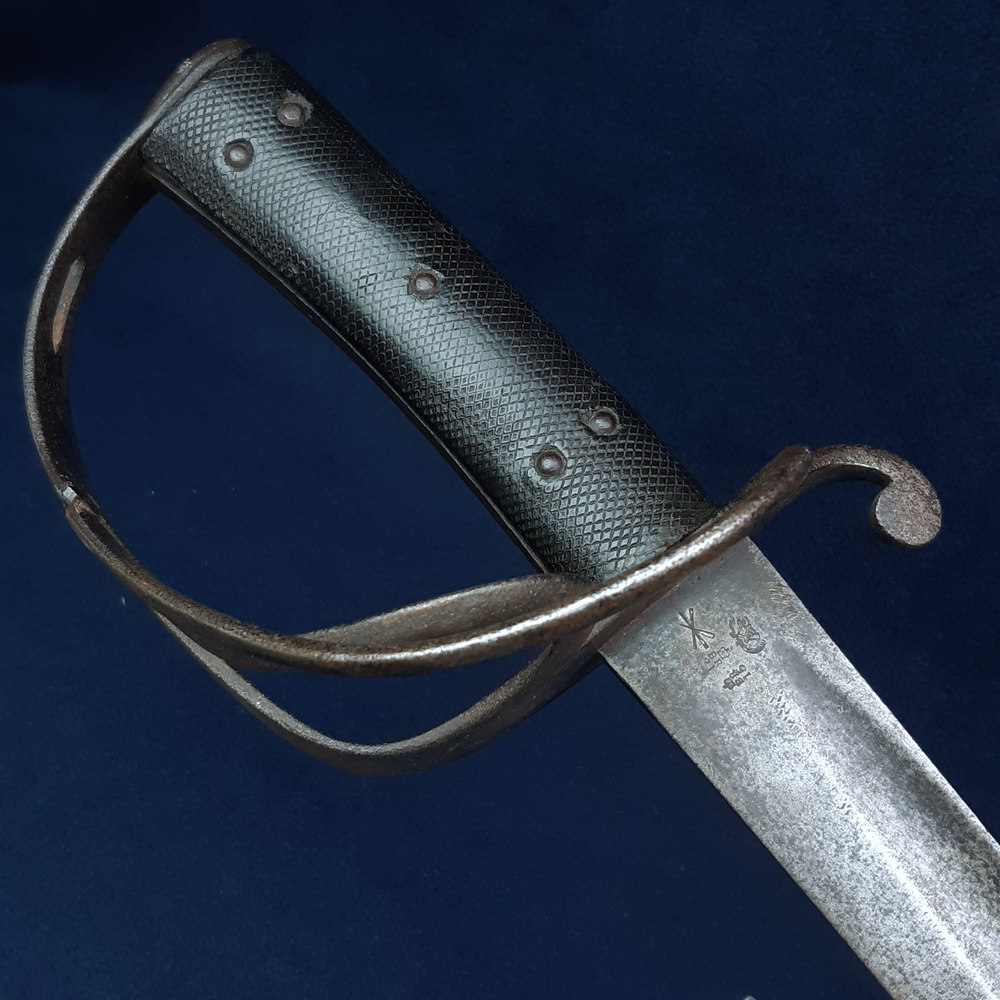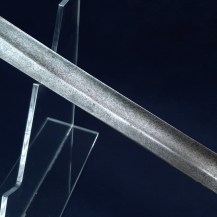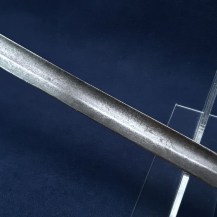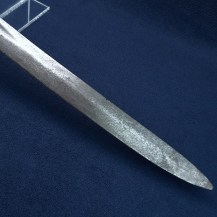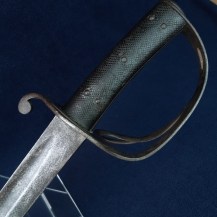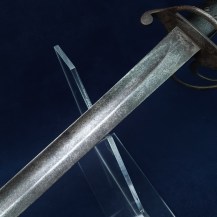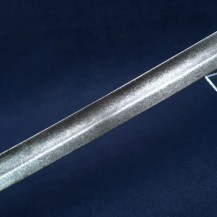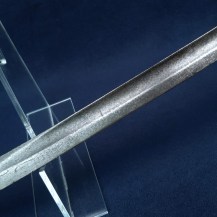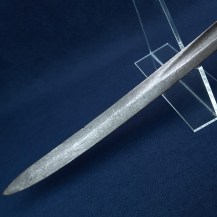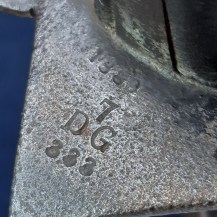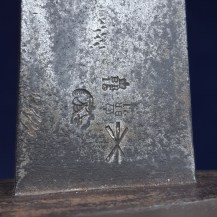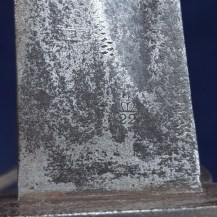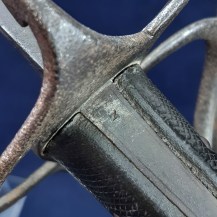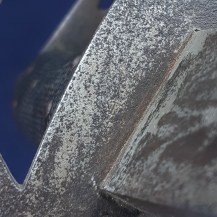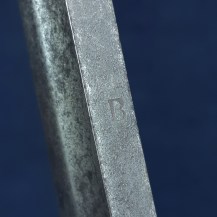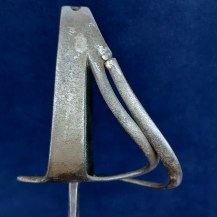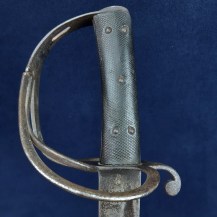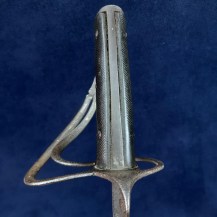British Anglo-Egyptian War 1853 Pattern Cavalry Trooper’s Sword, 7th Dragoon Guards
With date and regimental markings pointing to its service in Egypt in the war of 1882, including the Moonlight Charge.
Curved, single-fullered sabre blade with spear point, three-bar steel hilt with quillon and thumb guard. Full-width exposed tang, black grips of pressed leather over wood, secured by five rivets. No leather washer. No scabbard. Blade 35 1/8 inches (89.2cm) in length, the sword 40 11/16 inches (103.3cm) overall.
The inside of the hilt is engraved with ‘1880’ over ‘7 DG’ over ‘333’ signifying that this was weapon number 333 issued to the 7th (The Princess Royal's) Dragoon Guards in the year 1880.
The blade is stamped at the ricasso on one side with a knight’s helm, indicating the manufacturer C F Kirschbaum of Solingen, as well as two Birmingham repair marks of a crown over ‘BR’ and a mark of two broad arrows point to point, a mark which was placed on equipment that was obsolete or to be sold off. The blade is stamped on the other side with a crown inspection stamp.
The exposed tang is stamped with the letter ‘N’. The hilt is stamped near the shoulder with a letter ‘F’ which would originally have been covered by the washer. The spine of the blade is stamped with a letter ‘B’ indicating the point of balance of the finished sword, which was part of the quality control process to check for errors in blade shape.
In 1882 a British force was sent to Egypt to counter a rebellion by commander Ahmed Urabi against the Khedive, Tewfik Pasha. The 7th Dragoon Guards was included as part of the 1st (Heavy) Cavalry Brigade, together with the 4th Dragoon Guards and the Household Cavalry Composite Regiment, the first group of Household Cavalry to serve overseas since the Battle of Waterloo. Operating in difficult desert conditions, the regiment took part in the notable ‘Moonlight Charge’ at the Battle of Kassassin, wherein the 7th together with the Household Cavalry mounted a full charge at night under fire, cutting through Egyptian infantry in order to flank their artillery.
Owing to the darkness most accounts agree that the Egyptian guns were able to escape before the cavalry could find them, but the infantry, helpfully dressed in white uniforms which caught the strong moonlight, were cut down in numbers and routed. The 7th suffered only three men wounded and one officer, attached from the 3rd Dragoon Guards, killed. The dashing charge was widely reported and was pivotal for the Household Cavalry in justifying their continued existence after the war. The 7th took part in further attacks leading up to the decisive Battle of Tel el Kebir, after which they pursued and captured fleeing enemy forces and captured Cairo.
The regiment remained in Cairo as a garrison until February 1883 when they embarked to return home. The 7th took part in the Boer War and First World War, before amalgamating with the 4th Royal Irish Dragoon Guards in 1922 to form the 4th/7th Royal Dragoon Guards. This was amalgamated with the 5th Royal Inniskilling Dragoon Guards in 1992 to form the modern Royal Dragoon Guards.
A group of photographs in the Royal Collection taken just after their return to England, posed in their campaign equipment, prove that troopers and NCOs of the 7th Dragoon Guards carried the venerable 1853 Pattern sword to Egypt (see ‘Afghanistan and Egypt Portraits 1879 and 1882’, specifically RCIN 2501521, 2501522 and 2501523). The 1864 Pattern saw only limited issue and does not appear to have ever reached many regiments, while the 1882 Pattern was not issued to any units until 1883.
The remnants of black paint on this sword (seen on the inside of the hilt, mainly in the recesses around the top of the grip and near the sword knot slit) are also interesting, as contemporary accounts suggest that the cavalry took measures to reduce reflection from their equipment on this campaign. This is one of the earlier examples of camouflage I know of among the cavalry, possibly a lesson learned from the Second Afghan War. While on the sea journey to Egypt the Household troopers allowed their usually polished metal accoutrements to rust, while at the same time their swords were ‘browned by burning blade, hilt and scabbard’. The 7th may have followed a similar philosophy with the application of paint. Some of the dark appearance of the sword may be deliberate browning, although this is now difficult to distinguish from patination.
The tip of the blade is rounded, some nicks and chips to both the true and false edges. The outermost bar of the hilt has been bent upwards towards the blade, possibly as the result of an impact. It has a break where it connects to the other two bars, probably as a result of the same damage. This break has been previously repaired with what looks like rough soldering. The metalwork is all darkly patinated with some pitting. The leather of the grip has handling wear and some surface-level cracking.

